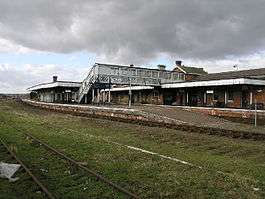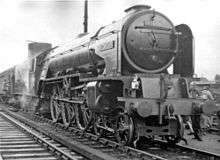Sleaford railway station
| Sleaford | |
|---|---|
 | |
| Location | |
| Place | Sleaford |
| Local authority | North Kesteven, Lincolnshire |
| Coordinates | 52°59′44″N 0°24′37″W / 52.995488°N 0.410350°WCoordinates: 52°59′44″N 0°24′37″W / 52.995488°N 0.410350°W |
| Grid reference | TF067454 |
| Operations | |
| Station code | SLR |
| Managed by | East Midlands Trains |
| Number of platforms | 3 |
| DfT category | E |
|
Live arrivals/departures, station information and onward connections from National Rail Enquiries | |
| Annual rail passenger usage* | |
| 2010/11 |
|
| 2011/12 |
|
| 2012/13 |
|
| 2013/14 |
|
| 2014/15 |
|
| National Rail – UK railway stations | |
| * Annual estimated passenger usage based on sales of tickets in stated financial year(s) which end or originate at Sleaford from Office of Rail and Road statistics. Methodology may vary year on year. | |
|
| |


Sleaford railway station serves the town of Sleaford in Lincolnshire, England. The station is 21.25 miles (34 km) south of Lincoln Central.
The station is now owned by Network Rail and managed by East Midlands Trains (EMT) Train Operating Company (TOC) who provide all rail services.
Sleaford is the last remaining market town in Lincolnshire to be served by both north-south and east-west lines.
History
Early proposals
The Sleaford Navigation, which canalised a 12.5 mile stretch the River Slea, opened in 1794. It facilitated the export of agricultural produce to the midlands and the import of coal and oil. Mills sprang up along the river's course and the Navigation Company's wharves were built near its office on Carre Street.[1][2] In 1827, the River Witham Navigation committee investigated the possibility of a railway allowing Ancaster stone to be transported to the Sleaford Navigation. The cost of doing so and competition from other quarries meant that their plans came to nothing.[3]
An 1836 scheme envisaged a railway between Nottingham and Boston which would have stopped at Sleaford, but the plans never left the drawing board. Another attempt, the Eastern Counties scheme, unsuccessfully tried to build a railway between Lincoln and Cambridge, with a branch to Boston via Heckington and an extension to Sleaford. After protests from the Navigation company, the necessary Bill never passed. In 1845, the Ambergate Company designed a railway from Ambergate to Nottingham, with branches to Boston, Spalding, Grantham and Sleaford. A Bill to that effect passed through the Houses of Parliament in 1846, but the railway only reached Grantham. In the meantime, the more ambitious Great Northern Railway from London to York was also endorsed by an Act of Parliament; it passed through Grantham and a loop line from Boston to Lincoln was operating by 1848, yet its planned extension between Boston and Sleaford was not sanctioned.[4]
The railways arrive
A new plan emerged in 1852 and was presented before Parliament the following year. The Sleaford, Boston and Midlands Counties Railway would pass through Boston, Sleaford and Grantham. The proposals met with considerable support from businessmen in Sleaford, including a number of Navigation officials; they envisaged it as a mode of transporting coal and stone.[5] The Bill passed in August 1853. Constructed by Smith, Knight & Co. under the supervision of the engineers W. H. Brydone and Edward Harrison, the line between Barston, near Grantham, and Sleaford opened on 15 June 1857.[6][7][8] An elaborate set of celebrations were organised for the opening day of the new Sleaford railway station, which saw all of the town's businesses close to allow their employees chance take part in the festivities; over 700 men from the area were invited to a free lunch on the cricket fields.[9]
The Grantham-Sleaford line cost £130,000 to construct, averaging at £11,850 per mile; the extension to Boston opened on 12 April 1859, at a cost of £6,500 per mile, considerably cheaper thanks to the flat terrain (the hillier Ancaster area, by contrast, required cuttings).[10] From the outset, the rolling stock was owned by the Great Northern Railway Company, who took over ownership of the line on 1 July 1864.[11]
New connections
The Great Eastern Railway wanted to build a line from Cambridge to York, which would have passed through Sleaford and Bourne, but Parliament would not allow it.[12] The GNR submitted a proposal for a line between Bourne and Sleaford, which, after amendments to the route, was approved in 1865 and opened in 1872.[12][13] Next came the Great Northern and Great Eastern Joint Railway which opened from Spalding through Sleaford to Ruskington and from there to Lincoln in 1882. The Sleaford company Kirk and Parry built the line, while the Ruskington-based builders Pattinson's constructed the new stations along the route.[13] The line was designed to transport freight, which necessitated an avoiding line around Sleaford;[14] Sleaford station was also extended.[15] The last new line through Sleaford ran to RAF Cranwell and opened in 1916.[16]
Operations and later history
The Cranwell branch ran at a loss: in response to a Parliamentary Question, it was revealed that, allowing for a credit in respect of the c.15,000 tons of Government stores that were transported along it during 1924, the line made a loss of some £3,570, although it was reported that "any alternative means ... would involve considerably greater expenditure".[17] Having ceased to carry passenger traffic in 1927, it closed completely in 1956.[16]

Passenger services on the Bourne branch ceased on 22 September 1930.[12] The Spalding line closed in 1964.[14]
The Grantham to Boston and Spalding to Lincoln lines remain open, as does the north to south link line bypassing the station. This has recently been refurbished by Network Rail and returned to full operation after several years of disuse[18] (as part of the plan to route more freight trains onto the latter and away from the busy East Coast Main Line).
Sleaford is still one of only a few places still to have signal boxes named 'North', 'South', 'West' and 'East' around the area. With the North and South boxes on the Peterborough to Lincoln Line, and then the West and East boxes are at each end of the station on the Grantham to Boston Line. So if travelling from Lincoln to Peterborough on the train you would pass all four boxes. The North and South boxes are however due to be decommissioned as part of the upgrade work mentioned above at the end of 2013.
Services
As of December 2015 there is an approximately hourly service each weekday to Nottingham via Grantham and to Skegness.[19] A limited service operates on Sundays with additional trains during the summer months.
There is also an hourly service on the Peterborough to Lincoln Line northwards to Lincoln and southwards to Spalding and Peterborough – the Peterborough service does not run in the evenings. There is no Sunday service on this line.[20]
| Preceding station | Following station | |||
|---|---|---|---|---|
| East Midlands Trains | ||||
| East Midlands Trains Mondays-Saturdays only | ||||
| Historical railways | ||||
Line and station open | Great Northern and Great Eastern Joint Railway | Line open, station closed |
||
| Disused railways | ||||
| Terminus | Great Northern Railway | Line and station closed |
||
Cranwell Line and station closed | Great Northern Railway | Terminus | ||
References
Citations
- ↑ Pawley 1996, pp. 64–66
- ↑ "History – The Company". Sleaford Navigation Trust. Retrieved 29 November 2014. Archived at the Internet Archive on 29 November 2014
- ↑ Ellis 1981, p. 79
- ↑ Ellis 1981, p. 79-80
- ↑ Ellis 1981, p. 80
- ↑ Ellis 1981, pp. 80–81
- ↑ Historic England. "Sleaford and Boston Branch Railway (1365060)". PastScape. Retrieved 24 August 2015.
- ↑ "Opening of the Boston, Sleaford and Midland Counties Railway.-Grantham to Sleaford". Illustrated London News. 20 June 1857. Retrieved 24 August 2015.
- ↑ Ellis 1981, pp. 81–82
- ↑ Ellis 1981, pp. 83–84
- ↑ Ellis 1981, p. 85
- 1 2 3 Historic England. "Bourne & Sleaford railway (1365418)". PastScape. Retrieved 15 December 2010.
- 1 2 Ellis 1981, p. 86
- 1 2 Historic England. "Spalding and Lincoln Railway (1365440)". PastScape. Retrieved 25 August 2015.
- ↑ Historic England. "Sleaford railway station (1062114)". National Heritage List for England. Retrieved 16 March 2015.
- 1 2 "Heritage Gateway Record for RAF Cranwell – Reference Name MLI83189". Lincs To The Past. Lincoln, England: Lincolnshire Archives. 2 March 2012. Retrieved 30 May 2012.
- ↑ "Cranwell and Sleaford Railway. HC Deb 17 June 1925 vol 185 cc494-5". Hansard 1803–2005. UK Parliament. 17 June 1925. Retrieved 30 May 2012.
- ↑ Network Rail starts renovation work on Sleaford Avoiding Line Railway Technology website news article; Retrieved 3 July 2013
- ↑ GB eNRT December 2015 Edition, Table 19
- ↑ GB eNRT 2015-16 Edition, Table 18
Bibliography
- Ellis, Charles W. R. (1981), Mid-Victorian Sleaford: 1851 – 1871, Lincoln: Lincolnshire Library Service, ISBN 9780861111022
- Pawley, Simon (1996), The Book of Sleaford, Baron Birch for Quotes Ltd., ISBN 0860235599
External links
- England – Lincolnshire (Map). 1:10,560. County series, Epoch 1. Ordnance Survey. 1891. Sheet 106/NW. ; Sleaford station on 1891 OS map.